Relationships among the O-antigen gene clusters of Salmonella enterica groups B, D1, D2, and D3
- PMID: 9473060
- PMCID: PMC106985
- DOI: 10.1128/JB.180.4.1002-1007.1998
Relationships among the O-antigen gene clusters of Salmonella enterica groups B, D1, D2, and D3
Abstract
The O antigen is an important cell wall antigen of gram-negative bacteria, and the genes responsible for its biosynthesis are located in a gene cluster. We have cloned and sequenced the DNA segment unique to the O-antigen gene cluster of Salmonella enterica group D3. This segment includes a novel O-antigen polymerase gene (wzyD3). The polymerase gives alpha(1-->6) linkages but has no detectable sequence similarity to that of group D2, which confers the same linkage. We find the remnant of a D3-like wzy gene in the O-antigen gene clusters of groups D1 and B and suggest that this is the original wzy gene of these O-antigen gene clusters.
Figures




References
-
- Altschul A F, Gish W, Miller W, Myers E W, Lipman D J. Basic local alignment search tool. J Mol Biol. 1990;215:403–410. - PubMed
-
- Bagdian G, Luderitz O, Staub A M. Immunochemical studies on Salmonella. XI. Chemical modification correlated with conversion of group B by bacteriophage 27. Ann N Y Acad Sci. 1966;133:405–424. - PubMed
-
- Brown P K, Romana L K, Reeves P R. Molecular analysis of the rfb gene cluster of Salmonella serovar Muenchen (strain M67): genetic basis of the polymorphism between groups C2 and B. Mol Microbiol. 1992;6:1385–1394. - PubMed
-
- Crossingham, C. (Difco Laboratories). Personal communication.
Publication types
MeSH terms
Substances
Associated data
- Actions
LinkOut - more resources
Full Text Sources
Other Literature Sources
Molecular Biology Databases

